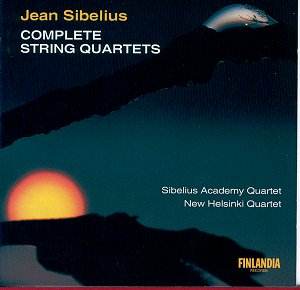Rather like his friend and practical supporter Granville
Bantock, we do not think of Sibelius in chamber music terms. Like Bantock,
his natural expressive environment is the orchestra. This is certainly
true of the mature years however his teens and twenties were littered
with chamber works designed for a domestic context: for music making
among friends and as a medium for learning. The 1885 quartet has precious
few Sibelian hallmarks. It is liquidly flowing, Schubertian and at times
touched with Haydn's euphony (as in the start of the Vivace).
The second movement is the most characteristic with two episodes suggestive
of what was to come - one a swirling figure which looks to En Saga
and the other echoing a passage in one of the delectable and still
too little heard Humoresques (violin and orchestra).
The A minor work is from four years later and already
we sense the music deepening and probing outwards towards a new vocabulary.
'Sight unseen' this is the sort of music which some might identify as
from the Weigl and early Zemlinsky school - late romantic, teetering
on the edge of expressionism. In the final allegro, the most classical
of the four movements, we sense transient ‘shadows’ from the Violin
Concerto.
We stay with the Sibelius Academy Quartet (including
the wonderful Arto Noras, cello) for the B flat major quartet, coupled
on the second CD with the Voces Intimae quartet. This work carries
the opus number 4 (its two predecessors were bereft of opus numbers).
A copy of the score carries the designation 'No. 2', making the A minor
No. 1. The B flat major has its moments as in the crystalline poise
of the Presto with its folk-rustlings and the rocking motif (suggestive
of En Saga again) in the finale but the first two movements are
queasy and unconvincing.
All doubts flee in the face of the five movement Voces
Intimae (inward voices - but why and what are they saying?), a work
of full maturity, written between the Third and Fourth Symphonies. A classical
purity fused with nature (as in the Third Symphony) can be heard in
Voces. In the Vivace the composer looks forward to the
Sixth Symphony and in the virtuosic finale to some of the suspenseful
string writing encountered in the Fifth Symphony. Oddly enough this
work reminded me very often of Smetana's 'From My Life' quartet
- something about the line of the themes, the desperation and the yearning.
This is not the first time Finlandia have had such
a coupling: 4509 95851-2 included the Academy's versions of the first
three quartets and an analogue tape of them playing the Voces Intimae.
To create the present, entirely digital, collection, Warners have
simply detached the New Helsinki Voces from its Grieg companion
(on 09027 40601-2) and substituted it for the Academy's analogue taping.
These are committed readings ripely advocated by the
artists and by Finlandia’s engineers. Although ten years separate these
sessions I did not detect any deficiency in the 1980s tapes.
Rob Barnett


